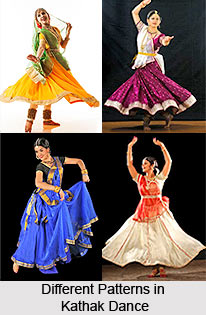 Dance patterns in Kathak are successive in nature and are named according to the varying degree of the complexity of the rhythmic pattern or on account of the mnemonics used. The tukra is a pure dance pattern which is the simplest variety where the mnemonics are of the Tabla. Tora is a formalized pattern that takes only a few types of mnemonics into consideration. Parana is a dance pattern which is performed to the mnemonics of pakhavaj.
Dance patterns in Kathak are successive in nature and are named according to the varying degree of the complexity of the rhythmic pattern or on account of the mnemonics used. The tukra is a pure dance pattern which is the simplest variety where the mnemonics are of the Tabla. Tora is a formalized pattern that takes only a few types of mnemonics into consideration. Parana is a dance pattern which is performed to the mnemonics of pakhavaj.
Thereafter the performance of tora is that of the tukra which is often presented as the chakkardar tukra. These are built in the same manner as the tirmanams of the varnam in Bharatnatyam. The dancer begins with a slow rhythmic pattern in vilambit laya. This is finally presented in a double or a triple laya. Here there is a successive progression and the relationship of the third laya to the first laya varies significantly. The entire sequence is repeated in multiples of three. The structure is built on an accurate mathematical sense. The dancer`s skill lies in building up this structure from the first beat of the rhythmic pattern or from any of the subsequent beats. The rule is that the dancer must end on the last beat of the metrical cycle or the first beat of the new cycle. The Parana is a dance pattern which is executed to the mnemonics with heavy and echoing aspirant sounds.
Kathak`s Nritta technique can be covered under these divisions. The tukras, the toras and the paranas have their subdivisions. One such classification is the composition which comprises sounds of various musical instruments known to north Indian music, such as, the nagara, pakhavaj and so on. It has also been defined as a category which has a combination of the Tandava and the Lasya styles. There are tukras which are known as the Sangeet ka tukras. These are compositions of one syllable or two syllables each, but with some musical quality about them. The common Sangeet ka tukra from the Jaipur School is `drig jagira drig jagira.` The Nritta portions are presented to a repetitive melodic line known as the nagma. Both the drummer and the dancer make endless variety of rhythmic combinations on this melodic line. The synchronization is all in the sphere of the metrical cycle.
The Ganesh Vandana and the kavita are two types of poetic compositions to which the dancer performs both Nritta and elementary abhinaya. This type of composition works on the matrika or the varnika chhanda of poetry. The poetic meter is set to an appropriate tala. A mnemonic pattern is added to the end of this poetic piece sometimes. The dancer interprets through gestures the poetic line and then executes the Nritta tempo on these mnemonics.
The Kathak dancer recites the bols of the dance rhythms. In Kathak this is an essential part of the dancer`s demonstration. The recitation grihe parhant becomes important as there is great emphasis laid on the accented and unaccented parts of the mnemonics. It is also important as the dancer rehearses the exact time intervals in the dance tempo before actually performing them on the floor. When the dancer executes a movement, the Tabla player repeats all the bols which had been earlier recited by the dancer.
The tattakara is the second and last aspect which is another way of presenting the dancer`s great mastery over rhythmic patterns. The dancer can execute fractional intervals of the beats of a single cycle. Against a basic pattern of sixteen beats, the dancer may execute a pattern of twelve beats by slowing the fractional count. The skill of the dancer lies in her harmonization with the Sama of the original metrical pattern. The end of the tattakara portion is a challenge as it requires perfect weight manipulation. The dancer tries to control the sound of the ankle bells restrict it to the jingling of one or two bells on her ankles. While executing these patterns the dancer must be absolutely static from the torso upwards. The charm of the dancer lies in apparently a static figure producing dynamic sounds.



















